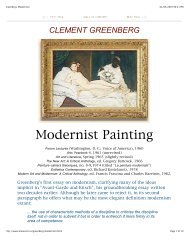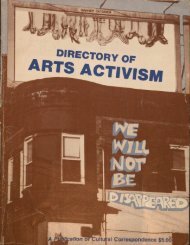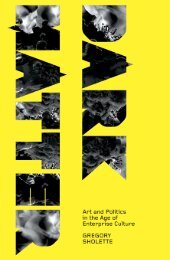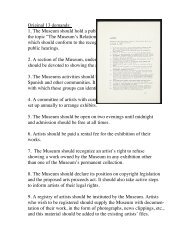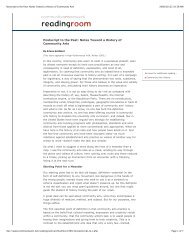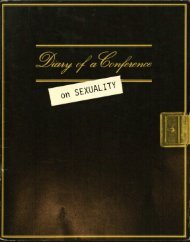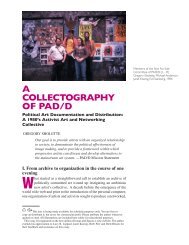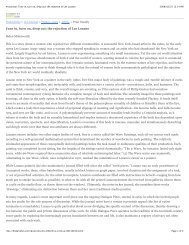Screen - Dark Matter Archives
Screen - Dark Matter Archives
Screen - Dark Matter Archives
You also want an ePaper? Increase the reach of your titles
YUMPU automatically turns print PDFs into web optimized ePapers that Google loves.
---II '7852 P Wollen, 'PhotographyandAesthetics', <strong>Screen</strong>.vol 19, no 4,Winter 1978/9,p 28.53 B Rosenblum ,'Style as Socia lProcess', AmericanSocioiogicQ IReview.vol 43. 1978. p 435.54 See R Barthes.'The Grear Familyof Man',Myt hologies,Paladin. 1973.p 100ff.specular regime, contributing to a unitary 'popular imaginary', Theprogressive incursion of photography into the institutional spacespreviously reserved for painting and sculpture has served to upsetthe conventional disavowal of the relation of 3rt to such otherrepresentational practices, if only because photography is centralto so many of them. As Peter Wollen has wri tten:For photography to be an art involves reformulating notions of art,rejecting both ma ter ial and formal purism and also the separationof 'art' fr om 'commerce' as distinct semiotic practices wh ich neverinterlock . Photo graphy is not an 'art·in·itsel/' any more than film,but an option within an inter-semiotic and inter· textual ' a Te n a ' . ~2Clearly, the discursive formation which supports the term 'art'out-runs anyone site; the term is used in n:spect of a complex ofinstitutions. practices, and representations: art museums, artmagazines, art schools, . . painting, photography, sculpture,art history, art theory, art ·criticism. across to representationsof the artist in the popular medi a: Kirk Douglas' Van Gogh,Anthony Quinn's Ga uguin. Charl eton Heston's Michaelangelo,and so on. Not the least important determinant in t.his complex isart administration; in an essay on the institutional determinants ofphotographic imagery Barbara Rosenblum concludes that fine artsphotography 'does not have unlimited capacity to absorb all typesof imagery ', and that it diffe rs fr om news and advertising photographyin that determinants upon imagery 'are generated primarilythrough the distribution systems , rather than through the organisationof pro du c tio n ' . ~3 Modernist discourse rules the distributionsystems of art phorography aided extensively by John Szarkowski'sdirectorship of the Department of Photography at the Museum ofModern Art, New Yo rk - the institution wh.ich has served asprimary power centre and ideological anchor for the expansion of'art photography' e.\!en prior to, but certainly since, Szarkowski 'spredecessor Ed ward Steichen launched The Family of Man exhibitionthere in 1955. The Family of Man woul d appear to have foregrounded'content', history ; in facr its seamless totali ty collapsedin upon a single humanist myth .~" The lines of today's superficiallyquite different 'formalism' ultimately converge within the samehumanist perspectives.E H Go mbrich has traced the lineage of the belief in the ineffablepurity of the visual image. Plato puts into the mouth ofSocrates a doctrine of two world s: the world of murky impedectionto which our monal senses have access, and an 'upper v,orId'of perfection and light. Discursive speech is the tangled and ineptmedium to which we are cond emned in the former, while in thelatter all th.ings are communicated visually as a pure and unmediatedintelligibiHty which has no need for words. The idea thatthere are two quite distinct forms of communication, words andimages, and that the latter is the more direct, passed via theNeo-Platonists into the Christian tradition. There was now heldto be a divine language of things, richer than the language ofwords; those who apprehend the difficult but divine truths enshrinedin things do so in a flash, without tbe need of words andarguments. As Gombrich observes, such traditions, 'are of morethan antiquarian interest. They still affect the way we talk andthink about th'e art of our own time',oo Foucault has directed ourattention to the action of power in the truth-effect of 'the way wetalk and think' within and across our major institutions: Society isordered on the basis of what it holds to be true ; truth does notstand outside discourse, wa iting to be 'expressed' by it; a truthis produced by material fo rm s of discourse inscribed in concretepractices. The global 'truth' whose perpetual regeneration isguaranteed across the discursive formation of art is that of thetranscendent freedom of the sovereign individual - that 'freedomof the spirit' (a spirituality whose natural realm is [ha t of light,pure vision) which we are guaranteed in exchange for the subjectionof the body to extant structures of power.The 'an is t' discovers the truth in perplexed appearances onbehalf of those unable to see it fo r themselves. The calling of the'left' artist is no less eleva ted , it is that of Foucault's 'universal'left intellectual, who speaks as 'the consciousness/ consci enceof everyone'. ~6 Again, it is a matter of a discourse unered fr omone place on behalf of those who stand in another - the politicalis permanently displaced by a perpetual elsewhere, as if theactuality of dominance, repression, exploitation, subjection to aspecifi c order, did not insinuate itself throughout the very fibre ofart traditions and institutions themsehJes, (as if 'political' engagementwere a fixtu re wh ich can only be pla yed 'away'). There havebeen t\'iO main conseque nces of this left humanism: on the onehand, the total evacuation of considerations of the political fromart production itself, which becomes the receptacle of a ll that is'timeless', 'biological', in 'human nature'; on the other the completeabandoning of the dominant sectors of (he art institution.s(certainly, a difficult and hostile environm ent) in favour of a'popular' art of posters, banners, and mur a ls. ~ j To gain the groundconceded by these, the dominant tendencies, it is required thatthe familia r pronouncement 'everything is poli tical' be taken preciselyto the letter, rather than being used, as it is, as a segregationistgesture of laying aside (eg, 'art is poli tical - it's a bourgeoisweapon against the masses') . Thus Foucault:55 E H Gombrich.'leones Symbolicae'.inSymboliC Images,Phaidon, 1972.56 M Foucault, 'Thepolitical functionof the intellectual',Radical Philo·sop hy, no l7, 1977,P 12.57 Thus the casybecause-uncontradictaryalternarionin suchleft-Jeaning.pe riodicals asTime Out, NewSta tesman . andT he Village Voice,of occasionalpu ffs on 'radical'artists (accompanyingphotograph'rhe artistwith his/he rwo rk' mandato ry),\....ith orhcrwiseunb roken stringsof art re viewsindistinguishablefrom those in thet horoughlybourgeoispress.79



